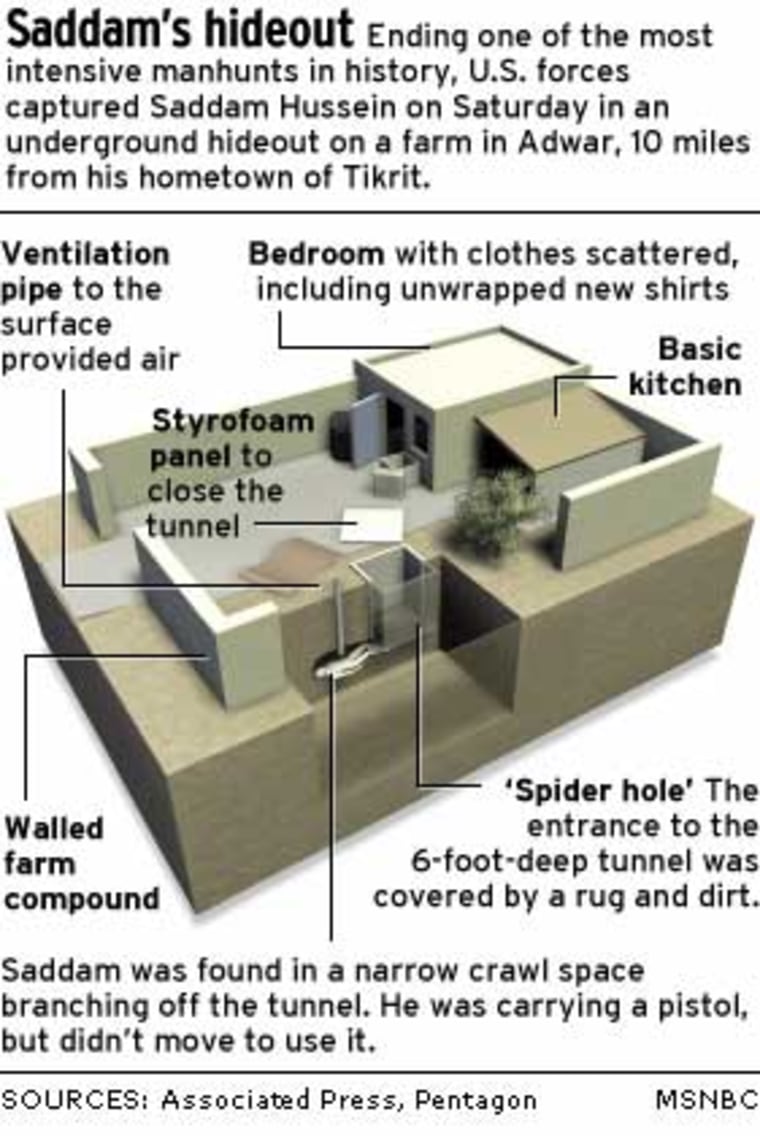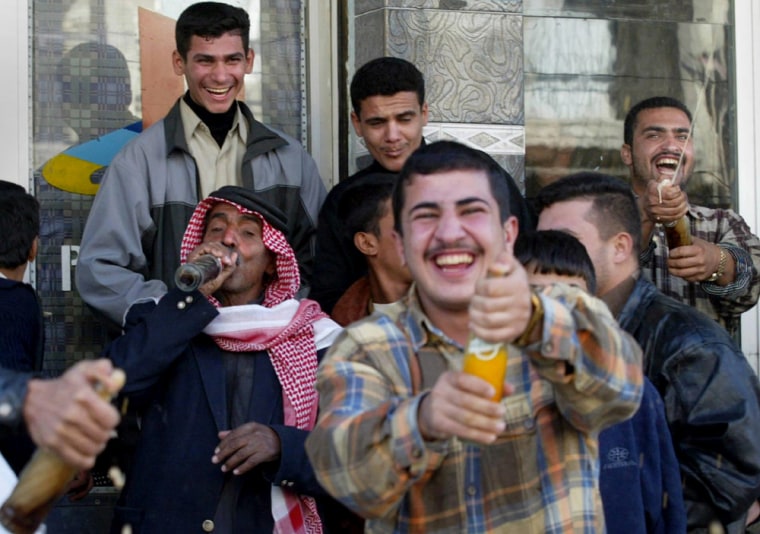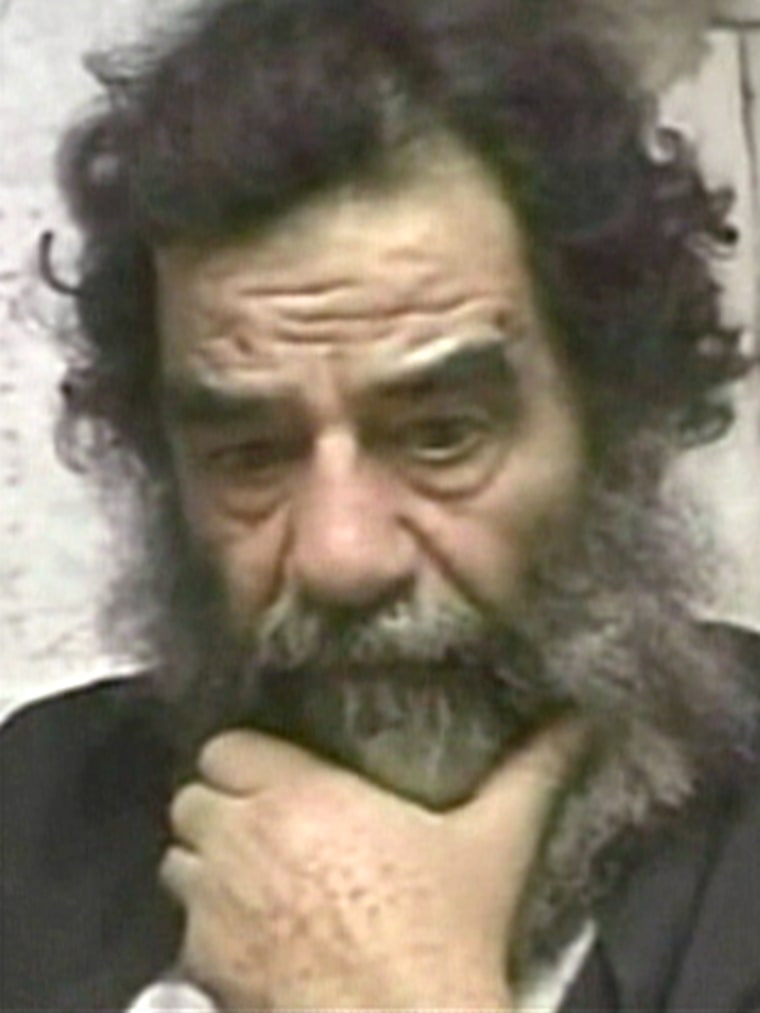Eight months after the fall of his government, former Iraqi President Saddam Hussein was captured by U.S. forces near his hometown, Tikrit, where he was hiding in a hole in the ground at a modest farmhouse, U.S. officials said Sunday.
The arrest, which was managed without a single shot being fired, was a major victory for the coalition, which has been battling an insurgency for months, and for President Bush, who has fended off criticism for failing to find the toppled Iraqi leader.
Saddam, 66, evaded capture and assassination attempts since the U.S.-led coalition invaded Iraq on March 20. But Sunday morning, Bush was able to the White House had awaited for months: “Yesterday, December the 13th, at around 8:30 p.m. Baghdad time, United States military forces captured Saddam Hussein alive.”
Options for justice
The U.S. administrator in Iraq, L. Paul Bremer, said Saddam was captured in the town of Adwar, 10 miles south of Tikrit, ending one of the most intense manhunts in history. Adwar holds special significance for Saddam; it is where he swam to freedom while wounded, his official biography says, after he tried but failed to assassinate President Abdul Karim Qassem in 1959.
U.S. military officials told NBC News that while Saddam appeared disoriented at first, "he wouldn't stop talking" once he got his bearings. "He was so tired of running,” one official said.
Lt. Gen. Ricardo Sanchez, the top U.S. military commander in Iraq, who saw Saddam overnight, confirmed the deposed leader was cooperative. He described Saddam as "a tired man, a man resigned to his fate."
Addressing the nation Sunday, Bush promised "the former dictator of Iraq will face the justice he denied to millions. In the history of Iraq, a dark and painful era is over. A hopeful day has arrived."
Defense Secretary Donald Rumsfeld said Saddam would get the protections of a prisoner of war, with his treatment “governed by the Geneva convention.” But he also said it was too soon to make "snap decisions" about Saddam's fate.
"Here is a man who has killed so many tens of thousands, who will have to be held accountable and brought to justice in some form and some way,” Rumsfeld said in an interview with "60 Minutes."
Sanchez said U.S. authorities had yet to determine whether to turn Saddam over to a new Iraqi tribunal for trial. But Ahmad Chalabi, the outspoken leader of the Iraqi National Congress, said Saddam would be soon handed over to the Iraqi people for trial.
"It won’t be very long before a court case is prepared," he told BBC radio.
Chalabi and three other senior figures in the new Iraqi leadership visited Saddam early Sunday morning, along with Bremer and other U.S. officials, according to several reports.
"He was defiant" during the visit, Adnan Pachachi, an Iraqi Governing Council member and former foreign minister before Saddam took power, told the Washington Post. "He tried to justify his crimes by saying he was a just ruler."
A weary Saddam
U.S. forces aired a video showing a bearded Saddam being examined by a doctor who held his mouth open with a tongue depressor, apparently to get a DNA sample. They showed a photograph of Saddam after his face was shaved. U.S. military officials told NBC News he suffered a slight head injury.
Sanchez would not disclose where Saddam was being held. Dubai-based Al-Arabiya television reported he had been taken to Qatar for security reasons. The report could not immediately be confirmed and other reports speculated he was being kept at Baghdad International Airport, where many prisoners are guarded by U.S. troops.
"This success brings closure to the Iraqi people," Sanchez said. "Saddam Hussein will never return to a position of power from which he can punish, terrorize, intimidate and exploit the Iraqi people as he did for more than 35 years."
It also provides closure for Bush. Despite a $25 million bounty on his head, Saddam remained a political thorn in the president's side and an inspiration to anti-U.S. insurgents. The U.S.-led coalition sent out thousands of soldiers to search for him from its headquarters in the sprawling, gold-edged Republican Palace compound in Baghdad.
Even as he sounded a note of victory, Bush warned Saddam's capture "does not mean the end of violence in Iraq. We still face terrorists who would rather go on killing the innocent than accept the rise of liberty in the heart of the Middle East."
Many world leaders welcomed the news, including British Prime Minister Tony Blair. "Where his rule meant terror and division and brutality," Blair said, "let his capture bring about unity, reconciliation and peace."
Bush's potential opponents in next year's elections also offered praise, albeit tempered.
U.S. commanders believe Saddam, though in hiding, played a role in guerrilla violence that has killed hundreds of soldiers and civilians in Iraq.
In the latest attack early Monday, car bombs went off outside police stations around Baghdad, injuring at least four people. It was the second such attack in 24 hours.
Operation Red Dawn
Forces from the Army's 4th Infantry Division along with Special Forces captured Saddam, the U.S. military said. There were no shots fired or injuries in the raid, which was called Operation Red Dawn, Sanchez said.

A Pentagon diagram showed the hiding place as a 6-foot-deep vertical "spider hole," with a shorter tunnel branching out horizontally from one side. A pipe to the concrete surface at ground level provided air. The entrance to the hideout was under the floor of a small, walled compound with a room in one corner and a lean-to attached to the room.
The hideout was across a river from one of Saddam’s palaces, roughly in the middle of the compound.
He was just caught like a rat," U.S. Maj. Gen. Ray Odierno told reporters there. "It is rather ironic that he was in a hole in the ground across the river from these great palaces he built."
Saddam admitted his identity when he was captured. Sanchez said that two men affiliated with him were detained and that soldiers confiscated two Kalashnikov rifles, a pistol, a taxi and $750,000 in $100 U.S. bills.
A U.S. commander told The Associated Press on condition of anonymity that U.S. troops also discovered “descriptive written material of significant value.”
The official would not say whether the material related to resistance efforts, but Time magazine, quoting a U.S. intelligence official, said soldiers found a briefcase with a letter from a Baghdad resistance leader. Time also reported that after his capture, Saddam denied he had weapons of mass destruction and said the United States used them as a pretense to wage war.
The operation to nab the deposed Iraqi leader was based on information from a family “close to him,” Odierno said. But U.S. military officials told NBC News it was unlikely the informer would be eligible for the $25 million bounty on Saddam's head because he was a U.S. captive likely to face charges himself.
Celebrations, skepticism from IraqisCelebratory gunfire erupted in , and shop owners closed their doors, fearful that the shooting would make the streets unsafe. The scene echoed one on July 22, after Saddam's sons Qusai and Odai were killed in a four-hour gunbattle with U.S. troops.

"I'm very happy for the Iraqi people. Life is going to be safer now," said Yehya Hassan, 35, of Baghdad. "Now we can start a new beginning."
"This is the joy of a lifetime," said Ali Al-Bashiri, another resident.
In Tikrit, U.S. soldiers lit up cigars. "The intimidation and fear this man generated for over 30 years are now gone," Odierno said.
In the northern city of Kirkuk, shots were fired in the air as residents rejoiced — but those shots killed eight and wounded 80 more, a hospital official told the AP.
Elsewhere, some Iraqis still loyal to Saddam were distraught at the news. In the city of Mosul, where attacks on American troops have particularly intense, Noha Fakhri wanted to cry.
"I love Saddam," she said. "I had hope that he might return to power, but now I know he won't."
Others remained skeptical that the man who exerted his iron will over the nation's resident had been caught. "I heard the news, but I'll believe it when I see it," said Mohaned al-Hasaji of Baghdad. "They need to show us that they really have him."
